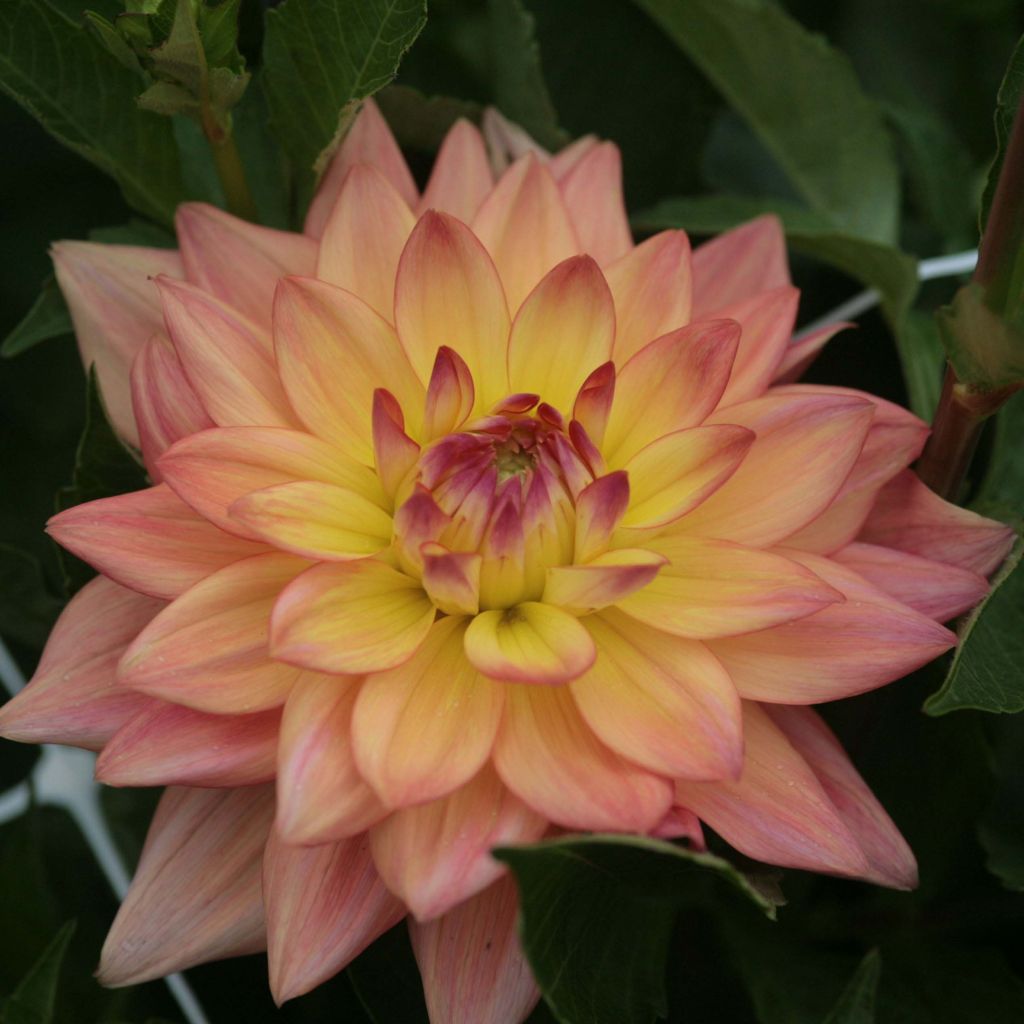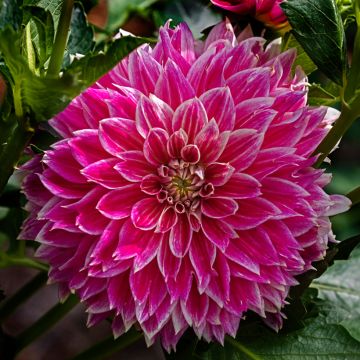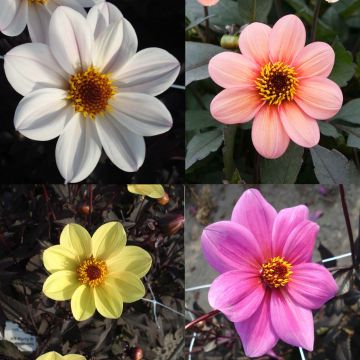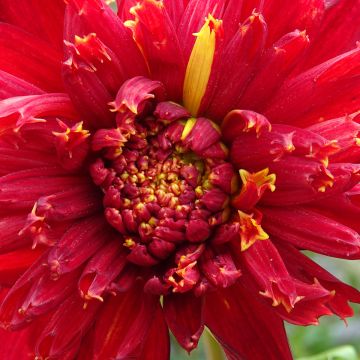

Dahlia Melody Dora
Dahlia Melody Dora
Dahlia Melody Dora
Dahlia
Full of very blooming buds, see photo.
Pierre, 27/06/2022
This item cannot be shipped to the selected country
Delivery charge from €5.90
More information
Schedule delivery date,
and select date in basket
This plant carries a 6 months recovery warranty
More information
We guarantee the quality of our plants for a full growing cycle, and will replace at our expense any plant that fails to recover under normal climatic and planting conditions.
From €5.90 for pickup delivery and €6.90 for home delivery
Express home delivery from €8.90.

Does this plant fit my garden?
Set up your Plantfit profile →
Description
The Dahlia 'Melody Dora' is a modest-sized dahlia with compact, sturdy, branched vegetation that can withstand bad weather. It produces double, medium-sized flowers that are generally bi-coloured. They are pale salmon pink, with yellow markings at the centre, and each petal is lightly tipped with light red, just like the centre of the flower. It blooms abundantly above very healthy dark green foliage from summer to autumn. This relatively short variety is perfect for sunny borders and flower pots and provides refined and colourful flowers for bouquets.
Dahlias belong to the Asteraceae family and are originally from the high plateaus of Mexico. The approximately 25,000 horticultural varieties obtained by humans have invaded gardens worldwide, much to our delight.
The 'Melody Dora' variety is part of the 'Melody' horticultural series, developed for its compact and branched growth habit and floribundity. It is a semi-dwarf dahlia, reaching a maximum height of 65 cm (26in) in all directions. It is also classified as a decorative dahlia, a horticultural category defined by the shape of the flower. In this group, the coloured ligules of the head are regularly arranged in a spiral, and they can be bent towards the stem or fringed, for example. 'Melody Dora' flowers are 13 cm (5in) in diameter. The golden heart of the flower only appears late, just before fading. The flowering period is from July to October. The habit is bushy and compact, requiring no staking. The highly branched stems are hollow, and the leaves are opposite, pinnately divided into 3 or 5 toothed lobes. The leaves and stems are dark green.
To encourage continuous flowering, remove faded flowers, or even better, regularly make large colourful bouquets by combining them with other varieties. The 'Melody' dahlias will create colourful spots in the front of flower beds alongside asters, heleniums, and cosmos. Also, consider pairing it with yarrow or Pennisetum villosum, a lovely fluffy grass, to bring softness and delicacy to the decor. This variety is particularly suitable for container gardening, making it easy to adorn the terrace or balcony.
Dahlias are the star plants of borders and cottage gardens, and they confidently accompany the most beautiful flowers but are also appreciated alongside vegetable plants. This tuberous plant was initially cultivated as a root vegetable for consumption in Mexico. However, its poor taste qualities relegated it to the status of an ornamental plant. Since then, the interest in their beautiful exuberance has never waned.
Report an error about the product description
Dahlia Melody Dora in pictures


Plant habit
Flowering
Foliage
Botanical data
Dahlia
Melody Dora
Asteraceae
Dahlia
Cultivar or hybrid
Other Ornamental Dahlias
Planting and care
The Dahlia 'Melody Dora' is easy to grow in all regions. For a bountiful flowering, it is good to follow a few simple rules. Plant the tubers in a sunny location after the last frost; rich, fresh, and well-drained soil is perfect. However, stagnant moisture would promote tuber rot. Do not hesitate to amend the soil with compost and sand if necessary. Work the soil deeply and enrich it, for example, with blood, fish and bone. Place your tuber and crumble the soil to fill without air pockets. Your dahlia should be covered with about 6 cm (2in) of soil. At the end of planting, water once abundantly and then regularly water during the first six weeks to help with rooting.
Dahlias are sensitive to cold; they need to be overwintered. In November, the first frost causes the foliage to blacken; it is time to dig them up. Carefully remove the tubers. Remove as much soil as possible. Let the foliage dry so that the tubers can replenish their reserves. Then cut the stems to 10 cm (4in). Spread your bulbs in a box of newspaper. Store them in a frost-free, dry, cool, dark place like a frost-free garage or attic. In milder regions experiencing only a few days of frost per year, it is possible to leave them in place. In this case, simply cover the ground with a layer of leaves or straw for protection.
Planting period
Intended location
Care
-
, onOrder confirmed
Reply from on Promesse de fleurs
Dahlias
Haven't found what you were looking for?
Hardiness is the lowest winter temperature a plant can endure without suffering serious damage or even dying. However, hardiness is affected by location (a sheltered area, such as a patio), protection (winter cover) and soil type (hardiness is improved by well-drained soil).

Photo Sharing Terms & Conditions
In order to encourage gardeners to interact and share their experiences, Promesse de fleurs offers various media enabling content to be uploaded onto its Site - in particular via the ‘Photo sharing’ module.
The User agrees to refrain from:
- Posting any content that is illegal, prejudicial, insulting, racist, inciteful to hatred, revisionist, contrary to public decency, that infringes on privacy or on the privacy rights of third parties, in particular the publicity rights of persons and goods, intellectual property rights, or the right to privacy.
- Submitting content on behalf of a third party;
- Impersonate the identity of a third party and/or publish any personal information about a third party;
In general, the User undertakes to refrain from any unethical behaviour.
All Content (in particular text, comments, files, images, photos, videos, creative works, etc.), which may be subject to property or intellectual property rights, image or other private rights, shall remain the property of the User, subject to the limited rights granted by the terms of the licence granted by Promesse de fleurs as stated below. Users are at liberty to publish or not to publish such Content on the Site, notably via the ‘Photo Sharing’ facility, and accept that this Content shall be made public and freely accessible, notably on the Internet.
Users further acknowledge, undertake to have ,and guarantee that they hold all necessary rights and permissions to publish such material on the Site, in particular with regard to the legislation in force pertaining to any privacy, property, intellectual property, image, or contractual rights, or rights of any other nature. By publishing such Content on the Site, Users acknowledge accepting full liability as publishers of the Content within the meaning of the law, and grant Promesse de fleurs, free of charge, an inclusive, worldwide licence for the said Content for the entire duration of its publication, including all reproduction, representation, up/downloading, displaying, performing, transmission, and storage rights.
Users also grant permission for their name to be linked to the Content and accept that this link may not always be made available.
By engaging in posting material, Users consent to their Content becoming automatically accessible on the Internet, in particular on other sites and/or blogs and/or web pages of the Promesse de fleurs site, including in particular social pages and the Promesse de fleurs catalogue.
Users may secure the removal of entrusted content free of charge by issuing a simple request via our contact form.
The flowering period indicated on our website applies to countries and regions located in USDA zone 8 (France, the United Kingdom, Ireland, the Netherlands, etc.)
It will vary according to where you live:
- In zones 9 to 10 (Italy, Spain, Greece, etc.), flowering will occur about 2 to 4 weeks earlier.
- In zones 6 to 7 (Germany, Poland, Slovenia, and lower mountainous regions), flowering will be delayed by 2 to 3 weeks.
- In zone 5 (Central Europe, Scandinavia), blooming will be delayed by 3 to 5 weeks.
In temperate climates, pruning of spring-flowering shrubs (forsythia, spireas, etc.) should be done just after flowering.
Pruning of summer-flowering shrubs (Indian Lilac, Perovskia, etc.) can be done in winter or spring.
In cold regions as well as with frost-sensitive plants, avoid pruning too early when severe frosts may still occur.
The planting period indicated on our website applies to countries and regions located in USDA zone 8 (France, United Kingdom, Ireland, Netherlands).
It will vary according to where you live:
- In Mediterranean zones (Marseille, Madrid, Milan, etc.), autumn and winter are the best planting periods.
- In continental zones (Strasbourg, Munich, Vienna, etc.), delay planting by 2 to 3 weeks in spring and bring it forward by 2 to 4 weeks in autumn.
- In mountainous regions (the Alps, Pyrenees, Carpathians, etc.), it is best to plant in late spring (May-June) or late summer (August-September).
The harvesting period indicated on our website applies to countries and regions in USDA zone 8 (France, England, Ireland, the Netherlands).
In colder areas (Scandinavia, Poland, Austria...) fruit and vegetable harvests are likely to be delayed by 3-4 weeks.
In warmer areas (Italy, Spain, Greece, etc.), harvesting will probably take place earlier, depending on weather conditions.
The sowing periods indicated on our website apply to countries and regions within USDA Zone 8 (France, UK, Ireland, Netherlands).
In colder areas (Scandinavia, Poland, Austria...), delay any outdoor sowing by 3-4 weeks, or sow under glass.
In warmer climes (Italy, Spain, Greece, etc.), bring outdoor sowing forward by a few weeks.





















































